

© 1995 by Christo & Taschen Verlag


© 1995 by Christo & Taschen Verlag
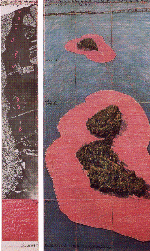
Surrounded Islands, Project for Biscayne Bay, Greater Miami, Florida
Drawing, 1983, in two parts
Pencil, charcoal, pastel, crayon, enamel paint, aerial photograph
and fabric sample
244 x 38 and 244 x 106.6cm
New York, Collection Simon Chaput
Foto: Wolfgang Volz
One of the most spectacular projects conceived and created by the Christos, a personal favorite of the present writer, was the Surrounded Islands (1980-1983) in Biscayne Bay, Greater Miami, Florida. This mammoth project accommodated to the natural environment, symbiotically blending with it without harm or disturbance was a work of great beauty, delicacy and poetry, as well as daring, and posed considerable risk and technical difficulty.
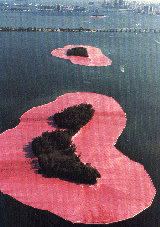
Surrounded Islands, Biscayne Bay, Greater Miami, Florida
1983
603,850 square meters of fabric floating around 11 islands
Foto: Wolfgang Volz
In a project they saw as an urban enterprise, the Christos set out to surround eleven man-made islands set squarely amidst the millions that populate Greater Miami, islands that were used mostly for dumping garbage. The preparations were long and complex, and involved, as in other projects, drawings, collages and photographs, as well as documentation and numerous meetings with government and local officials, in order to secure permissions. From April 1981, a team of attorneys, a marine engineer, four consulting engineers and a building contractor, a marine biologist, an ornithologist, and an expert on mammals, all worked steadily on preparing the Surrounded Islands Project. Marine and land crews picked up debris from the eleven islands, putting refuse in bags and removing some 40 tons of rubbish in all. Permits were obtained from the Governor of Florida, the City of Miami Commission, and numerous other authorities, including the U.S. Army Corps of Engineers: The US Army Corps of Engineers permit alone is six inches thick, reported the Miami Herald, thicker than a Bible, thicker than the Websters Third International Dictionary unabridged edition. And the result was one of the most unforgettable and poetic sights art has produced in modern times.
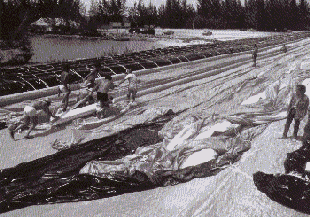
Surrounded Islands, Biscayne Bay, Greater Miami, Florida
1983
Foto: Wolfgang Volz
I well remember taking a helicopter and flying over the islands. The panama that was revealed before us showed yet again how precious was the Christos' gift for transformation. The landscape per se had been metamorphosed, for a short time, into another, beautiful reality, with luminous pink surrounds of fabric shining in breathtakingly unusual harmony with the tropical vegetation of the islands, the light of the Miami sky, and the colors of the shallow waters of the bay. Claude Monet's Water Lilies (1916) inevitably came to mind; the islands seemed to be floating pads of verdure and blossom, observed (rather than made) by an eye sensitive to every nuance of light and color.
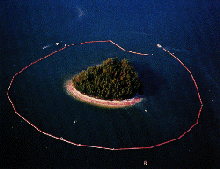
Surrounded Islands, Biscayne Bay, Greater Miami, Florida
1983
During the installation of Surrounded Islands, May 1983
Foto: Jeanne-Claude Christo
The choice of pink fabric was far from accidental. Pink, with the sweetish overtones of frangipani, will strike the stranger to Miami within a matter of hours as the symbolic color of the area, observed Werner Spies. Pink was the only natural choice of color in that part of the country the color of a euphoric artificiality. In the Christos' use of the color, there was both humor and affection. And the color did not go unglossed by the press. In Miami, noted The Orlando Sentinel (April 17, 1983), pink used to mean flamingos, sunsets and art deco hotels. Now it means Christo.
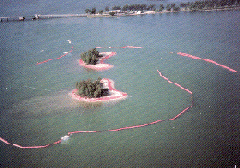
Surrounded Islands, Biscayne Bay, Greater Miami, Florida
1983
During the installation of Surrounded Islands
Foto: Wolfgang Volz
The Christos' soft intrusion into the life of the metropolis (as Werner Spies aptly put it) was completed on May 7, 1983, and the eleven islands in the area of Bakers Haulover Cut, Broad Causeway, 79th Street Causeway, Julia Tuttle Causeway and Venetian Causeway were surrounded with 60 hectares of pink woven polypropylene fabric covering the surface of the water, floating and extending 60 meters out from each island into Biscayne Bay. The fabric had been sewn into 79 patterns to follow the contours of the islands, and this work, done at the rented Hialeah factory, took from November 1982 till April 1983. A flotation strip was sewn into each seam, and, at the Opa Locka Blimp hangar, the sewn sections were accordion-folded to ease the subsequent unfurling on the water. This unfurling was begun on May 4, and, once the work was accomplished, the Surrounded Islands were tended day and night by over a hundred monitors in inflatable dinghies.
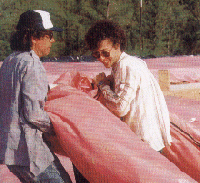
Christo and his son Cyril during the installation of Surrounded Islands
May 1983
Foto: Wolfgang Volz
The impact of this remarkable project went far beyond the local scene though no doubt the many who beheld the sight for themselves during the two weeks of installation were left with an impression permanently engraved upon their minds. On the spot the Christos' project created a two-week boom for the Miami tourist economy. One helicopter company sold 5,000 seats at $35 a time to witness the sight from above. But around the globe, as The New York Times reported (May 15, 1983), the Surrounded Islands were given prime time exposure by networks and newspapers [...] right up there with such headline stories as Hitler's diaries, the Israel-Lebanon draft agreement and the nuclear arms freeze.
Indeed, the author of the NYT piece, Grace Glueck, noted: No one can accuse the world of neglecting the artist Christo, that master manipulator of landscape and the media. In fact, it's probably safe to say that since the late 1960s [...] no other creator in the fine arts has commanded so much public attention, not all of it positive, to be sure.
That exposure, and the controversies that have invariably accompanied it, have become an inseparable part of the Christos' art projects. To the avant-garde of yesteryear, thumbing the nose at entrenched bourgeois philistinism or, at least, imagining that opposition equalled philistinism was always a means to obtain credibility, artistic vindication, success. The approach taken by the Christos is a different one. Artists whose integrity, talent and professional seriousness have been widely attested, they enlist the attention generated by the media, and turn it to their advantage, in good faith, relying on the mere fact of debate to consolidate their position and strengthen their case. At a time when many would still take the easy way out and, if they could, dismiss them as charlatans, the use of powerful allies makes the best of sense. Exposure and controversy are, quite simply, a means of generating the interest, and thus the funds, that go into the increasingly costly and complex projects conceived by the Christos, man and wife. (And the money the Christos putinto their projects frequently finds its way into the coffers of local communities, thus providing them with the multiple benefits of art, publicity, and plain cash.)

